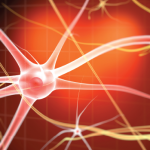“Once Lori taught me how to meditate, I was able to achieve a pain-free state for 10–15 minutes at a time,” Ms. Gluckman says. “After four months, I saw a definite improvement in how I felt and the number of things I was able to accomplish.”
Recent research confirms that people who practice meditation can access different brain regions to reduce pain. A November 2015 study, conducted at Wake Forest Baptist Medical Center, found that mindfulness meditation reduced emotional pain by 47% and pain intensity by 27%.
After a year, Ms. Gluckman was able to return to work full time and no longer needs a wheelchair. In fact, she has even taken up hiking.
Physioyoga: Going Beyond Traditional Physical Therapy
Yoga and PT have many common goals, including flexibility, strength, motor control, balance, posture and alignment, but Dr. Rubenstein Fazzio says one of the main differences is how breathing and visualization techniques are employed.
“Stress exacerbates many health problems, and yoga can balance stress and empower patients through visualization, meditation and asana [yoga postures],” explains Dr. Rubenstein Fazzio.
Pam Douglas, a writer based in Los Angeles, found this to be the case when she was referred to Dr. Rubenstein Fazzio’s clinic after tearing her meniscus.
“I initially saw Lori for my knee, but I also had back and shoulder problems, and in 2005, I underwent scoliosis surgery and had steel rods implanted in my spine,” Ms. Douglas says. “Lori explained that unless we corrected my posture and the way I walked, I would probably continue to experience pain.”
Over the course of three months, Dr. Rubenstein Fazzio worked with Ms. Douglas on stretches and yoga movements that would strengthen the back of her legs to better support her back.
“It was as much about learning how to care for my body as it was fixing it,” Ms. Douglas says. “In the beginning, Lori had to modify some of the exercises to avoid unnecessary stress on my joints and ligaments, but the end result was tremendous pain relief, more strength and increased range of motion.”
Ms. Douglas says physioyoga helped her visualize her healing process and how to work with her body to achieve the best possible outcomes.
“While a traditional physical therapist would have focused on my injury, Lori went beyond that and looked at how my injured knee impacted my entire body,” Ms. Douglas says. “She’s truly a gifted practitioner.”

